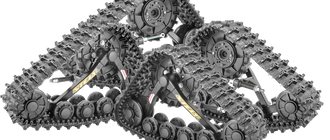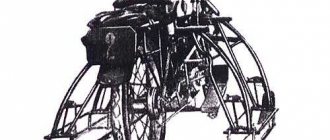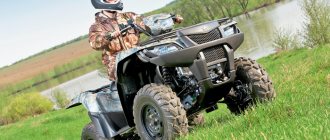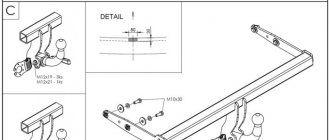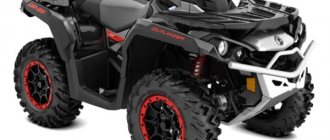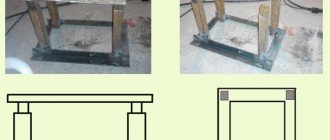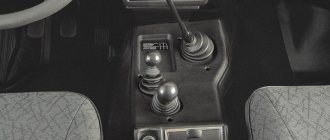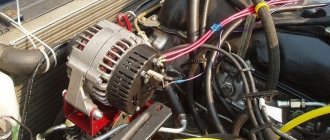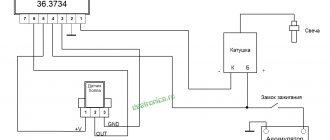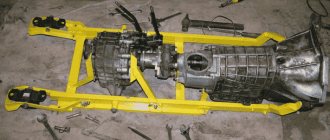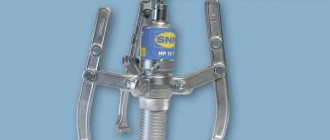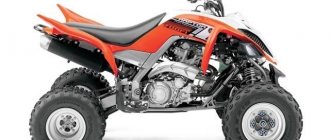Many of our compatriots dream of such a vehicle as an ATV. This hybrid of a tractor and a motorcycle combines their best qualities. It is used for driving over rough terrain, trips to nature or picnics, fishing, etc. The all-terrain vehicle is also actively used when performing various household tasks. An ATV is a fairly expensive vehicle, so many people decide to assemble it themselves. To do this, you will need to prepare the appropriate equipment and components. One of the popular options is to assemble an ATV from Oka with your own hands.
Many of our compatriots have an old but working car gathering dust in their garage. Oka is ideal for assembling an ATV. To do this, you will have to spend a certain amount of time and purchase the necessary parts. You will also need a welding machine and grinder, a set of keys, screwdrivers, and other hand tools. This is an exciting process during which the master will acquire new skills. If desired, a specialist will be able to assemble a homemade ATV from Oka with all-wheel drive.
At the initial stage, a drawing of the future vehicle is developed. You can use a ready-made scheme, but it is much more effective to create your own. When developing drawings for an ATV from Oka, you need to take into account that most of the parts can be removed from the old car.
Advantages of an ATV from Oka
An all-terrain vehicle assembled from Oka parts has many advantages over factory-produced models. One of the positive qualities is the efficiency of such an ATV. Since most of the parts will be taken from the donor vehicle, no significant financial investment will be required. If you have to buy additional parts, you only need a very small amount of them.
The weight of the ATV will be relatively light when compared with factory-produced all-terrain vehicle models, but the power will be significantly higher. The Oka has a two-cylinder liquid-cooled engine. For a car this may not be such a high figure, but for an ATV it is more than enough.
In this case, you can make your own 4x4 ATV with an Oka engine. The all-wheel drive all-terrain vehicle will be functional as well as versatile. It will be able to overcome significant obstacles on the road, cultivate gardens and vegetable gardens, and transport significant loads.
DIY ATV 4x4 with Oka Engine 11113
Quite simple and cheap to assemble
all-terrain vehicle
based on the Oka, it was made by Leonid from the city of Nyagan. The all-terrain vehicle is capable of reaching a speed of about 50 kilometers per hour, and can also overcome water obstacles by swimming. the car was made mainly for forays into remote areas of the forest for gathering.
To assemble such an all-terrain vehicle, the following parts and materials were required: 1) A body from an Oka car 2) a profile pipe for assembling the frame 3) A VAZ 1111 internal combustion engine 4) most of the chassis from a Niva 2121 5) SHAIN tires 6) A steering wheel from a VAZ 2109
Let's take a closer look at the work done on the all-terrain vehicle.
To begin with, the author decided to make the frame of the future all-terrain vehicle. the frame was made independently from a profile pipe available from the author.
The frame manufacturing diagram is shown below:
This is what the front axle of the assembled all-terrain vehicle looks like:
Transfer case installed:
The fastenings from the Muscovite bridge were cut off to install springs. Springs from the Muscovite 412 with stepladders were installed; for this purpose they were pre-sized and overcooked. Initially, the author planned to make a spring suspension, as is customary to do on all-terrain vehicles with a small mass of the Oka type, but decided that springs were still more reliable, since for springs it was necessary to complicate the frame to accommodate the travel of the springs and install more salen blocks for fastening. That is, the main factor in favor of spring suspension was simplicity and reliability.
After the main assembly, the author began testing the car. As the tests progress, minor improvements are also being made, in particular, deficiencies are identified and eliminated, work continues on the appearance of the vehicle, and the suspension system is being improved.
The weight of the all-terrain vehicle was about 800 kilograms. The all-terrain vehicle has the following dimensions: the length of the base is 210 centimeters, the width is 208 centimeters, the length of the entire all-terrain vehicle is 360 centimeters, the height is about two meters, the ground clearance is 40 centimeters.
Painting work was carried out, and foam was installed under the bottom for greater buoyancy:
For the same purpose, a camera can be attached to two straps in the front of the all-terrain vehicle; with this approach, you don’t have to worry about the stability of the vehicle on the water.
Over a short period of operation, several problem areas of the all-terrain vehicle were identified. In particular, the upper plates of the front springs were bent, so gussets will be installed. Problems with the oil also emerged; after 50 kilometers of travel, the oil level dropped significantly, since the engine was purchased in excellent condition, it is most likely not the problem. In addition, no oil leaks were found anywhere. the reason lies in the wet filter after overcoming water barriers. The holes in the top cover on the housing were sealed to prevent the filter from getting wet. The chassis did not reveal any problems.
The chassis has no breakdowns, mainly due to the low load coming from the wheels. These wheels fit perfectly into the Nivov suspension concept. however, for the all-terrain vehicle itself, it is advisable to install larger wheels, since the small diameter of the wheel, in turn, means a small volume of air in the tires, and therefore you have to resort to tricks in the form of foam plastic and additional chambers to overcome water obstacles. Also, the installed wheels have too weak a tread, which actually doesn’t work in mud. Over the course of 350 kilometers, all the studs on the wheels will wear out, and the tires will wear out quite quickly. A fallen log becomes a difficult obstacle to overcome.
But there are also advantages to this design:
The suspension travel is very soft, since the wheels are still wide, the all-terrain vehicle does not sit on the bridges and walks confidently on clay. These wheels eliminate heavy loads on the axles, which increases their service life. Well, the most important plus is the price, since the Niva chassis axles are quite cheap, but are suitable exclusively for this type of wheels.
If, for example, you install wheels with a diameter of 1300 or more, you will have to redo the chassis, in particular, install axles from the UAZ. Therefore, the 1300 Avtoros that the author has are currently idle, but in the future it is planned to replace the bridges with UAZ ones and, accordingly, tires.
In the meantime, in order to increase traction, it is possible to attach belts from oil rockers to the SHAIN wheels, but it is not a fact that the transmission will withstand such loads. Therefore, the author drives as is, because he fears for the axles and front gearbox. It may be possible to install some kind of compensating clutch on the all-terrain vehicle before it is completely modernized.
Also interesting: buy a new Lada 4×4 Bronto 2021 from an official dealer in Moscow, prices “
Weaknesses in the all-terrain vehicle's suspension were also identified; after hitting a log at a speed of 10 km/h, the steering rod was bent, which subsequently failed. The rod was replaced and reinforced with f 10 rods on both sides for reliability.
As for driving an all-terrain vehicle through swamps, unfortunately it fails, but it’s not the wheels that matter, rather the terrain conditions. in any case, the all-terrain vehicle is capable of independently driving out of such situations when the lock is turned on.
The Oka gearbox is enough, even a low gear is not required. The steering rods, by the way, were installed from the fret nine, but the author plans to redo and replace them with Niv ones. The steering is quite light, but there was an error in the angles relative to the bipod.
Below is shown the connection between the Oka engine and the steering column from the Niva. The flange is processed under the driveshaft of the vase; for this, the intermediate driveshaft of the field is taken, and a small CV joint with studs is removed from it. There is a manual transmission under the flange, the spline of this CV joint is the same as that of the axle shaft from the oka. A driveshaft is made from the inner CV joint of the Oka, using an axle shaft and a small CV joint of the Niva.
It turns out something like this, do not forget about the bearing, it is necessary to reduce the load on the transfer case.
From the transfer case it is transmitted to the axles as usual:
Photos of the finished all-terrain vehicle:
Author of the all-terrain vehicle: Leonid from the city of Nyagan.
Frame assembly
To make an ATV from Oka, you must first make a base. You should work in a heated room with good ventilation or outdoors under a canopy. At the first stage, you need to assemble a frame, which is created by welding from the following parts:
- The lower and upper spars are made of two pipes with a round cross-section. The metal thickness should be 3 mm, and the cross-section diameter should be 25 mm.
- Auxiliary spars, which are used for struts.
- The spars are bent, which form the upper and lower planes.
- Clamps for shock absorbers and levers.
To install various components on the frame, you need to purchase the appropriate number of metal brackets and other small parts.
Finalization of the design
After assembling the frame, you should take care of the transmission, which will be unique in this system. Despite the fact that the engine is all-wheel drive, there is no gearbox in the system. In this case, the engine is installed lengthwise, which allows you to change gears and synchronize the transmission with the output shafts. If in the Oka the right and left wheels worked together, then in the ATV it is necessary to create a different type of drive. Two front and two rear wheels will work synchronously. Such modification is necessary in order to provide the all-terrain vehicle with the appropriate performance characteristics for driving on hard off-road conditions.
The technician needs to move the units on the frame to the left, since the horizontal unit of the transmission shafts will decrease. Otherwise, the system will not function correctly. The Oka gearbox needs appropriate modifications. A gear pair is removed from it, instead of which a chain drive will be installed. This will balance the speed and also increase torque at the same time.
The gear shift needs to be lengthened and the gear shift lever installed on the left. There are 4 gears in this design: two in front and two in rear. As the system operates, the speed position of the lever will change.
It is recommended to remove the gearboxes that are installed between the wheels. This is a characteristic feature of cars produced by VAZ. The axles are removed, like the stocking, and shafts designed for front-wheel drive vehicles are installed instead.
Rebuilding the transmission is the most difficult part of assembling an ATV system from an old vehicle.
Improving the design
In addition, on an ATV, the engine must be placed lengthwise to ensure the operation of the gear change and also to synchronize the gearbox with the output shafts. And if in a car the synchronization goes to the right and left wheels, then in an ATV it goes to the front and rear axles, respectively.
Also, do not forget to take care of the location of the entire structure. Since this is not a car, the entire unit will need to be moved slightly to the left. This is necessary so that the horizontal angle of the transmission shafts decreases, otherwise the ATV will operate unevenly.
The gearbox will also have a number of unique features. For example, it is recommended to immediately remove the gear pair and install a chain drive instead. This is necessary to balance the speed of movement and at the same time increase torque.
Gear shifting in this case is also longer. It is better to install the speed shift lever on the left. There will be four gears in total, two at the front and at the rear, and accordingly the position of the speed lever will change.
In addition, it is recommended to remove the gearboxes between the wheels, typical for VAZ cars. The axles are removed together with a stocking, and shafts are installed instead for front-wheel drive models. Replacement is carried out in the same way in other parts of the transmission. In general, assembling an ATV from Oka’s car is not difficult, just some parts will require replacement. However, the ATV will have a largely different layout and tasks, which means the assembly will need to be adapted. Transmission is one of the most difficult stages; everything else will not require such effort. If you want to do something unique, do not forget about drawings and calculations. This will give you a solid base to work from.
Completing the build
The corresponding attachments, controls, and gas tank are installed on the frame. All elements are firmly fixed to the frame. The battery needs to be changed, buy the appropriate battery that is suitable for the ATV. Traveling in nature far from home is very important, since without high-quality power to the electrical system, the vehicle will not be able to move.
When all the components and mechanisms are installed, you need to trim the body with metal or plastic parts. The first option is preferable. They will be able to protect all components from damage, since the body of the ATV is often subject to impacts. The surface of the body is primed and painted. You can decorate it with stickers of standard or original designs. If necessary, you can print any image.
At the last stage, headlights, rear-view mirrors, trunk and other additional structural components are installed. After completion of the work, the functionality of the system is checked and modifications are made if necessary.
A homemade ATV is assembled not only from the Oka: read how you make your own ATV from the Ural, Ant, Dnepr, from a walk-behind tractor and a scooter.
